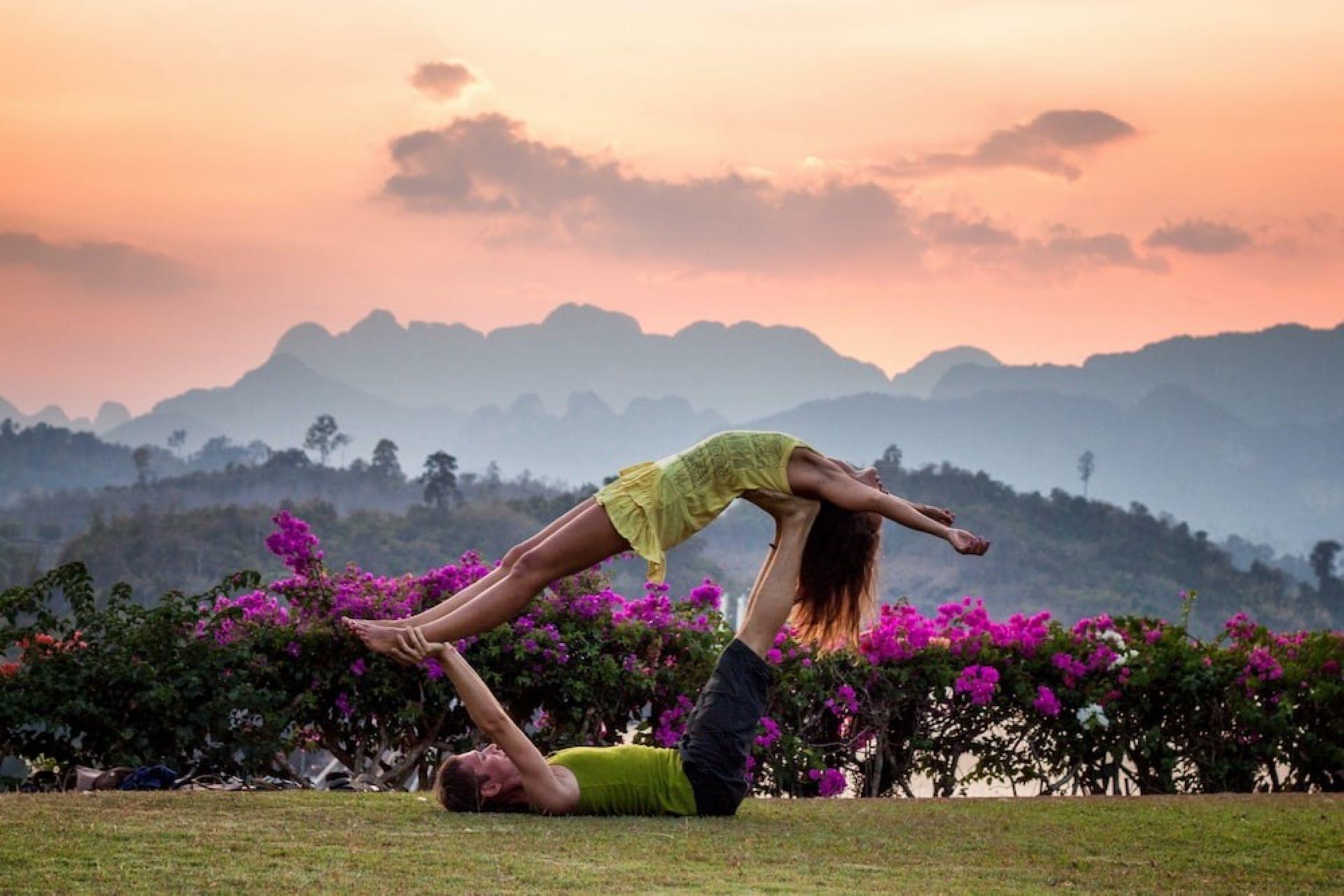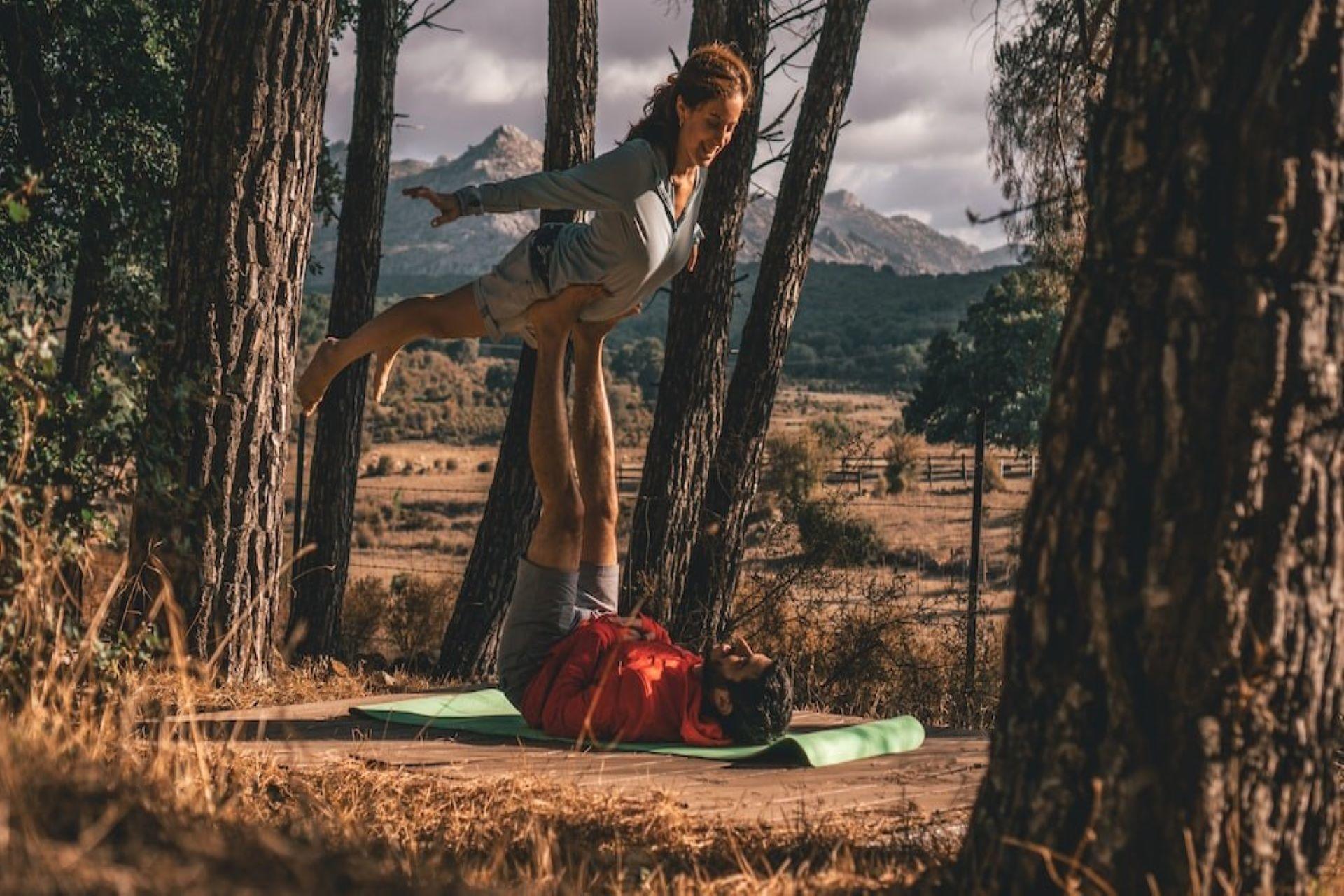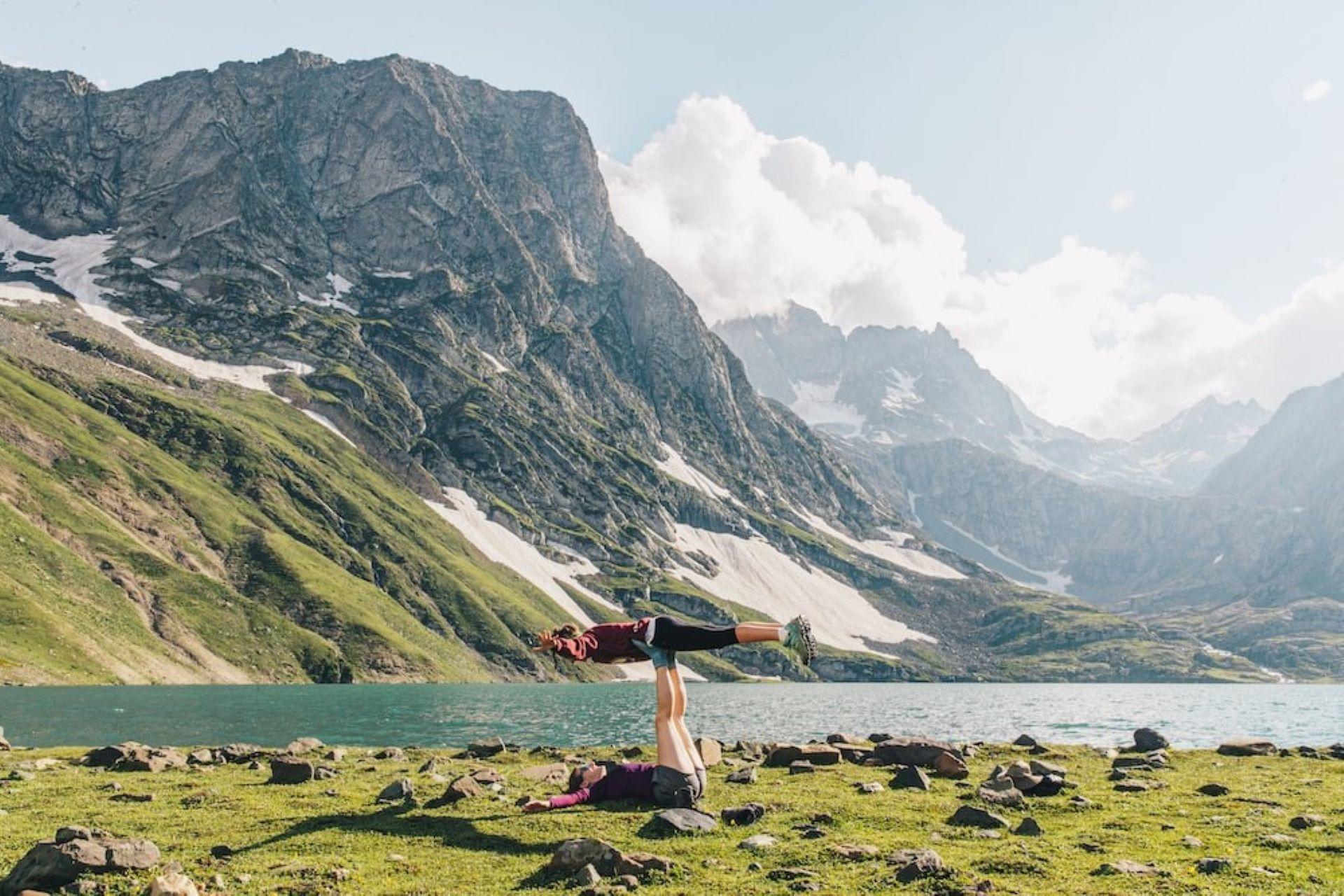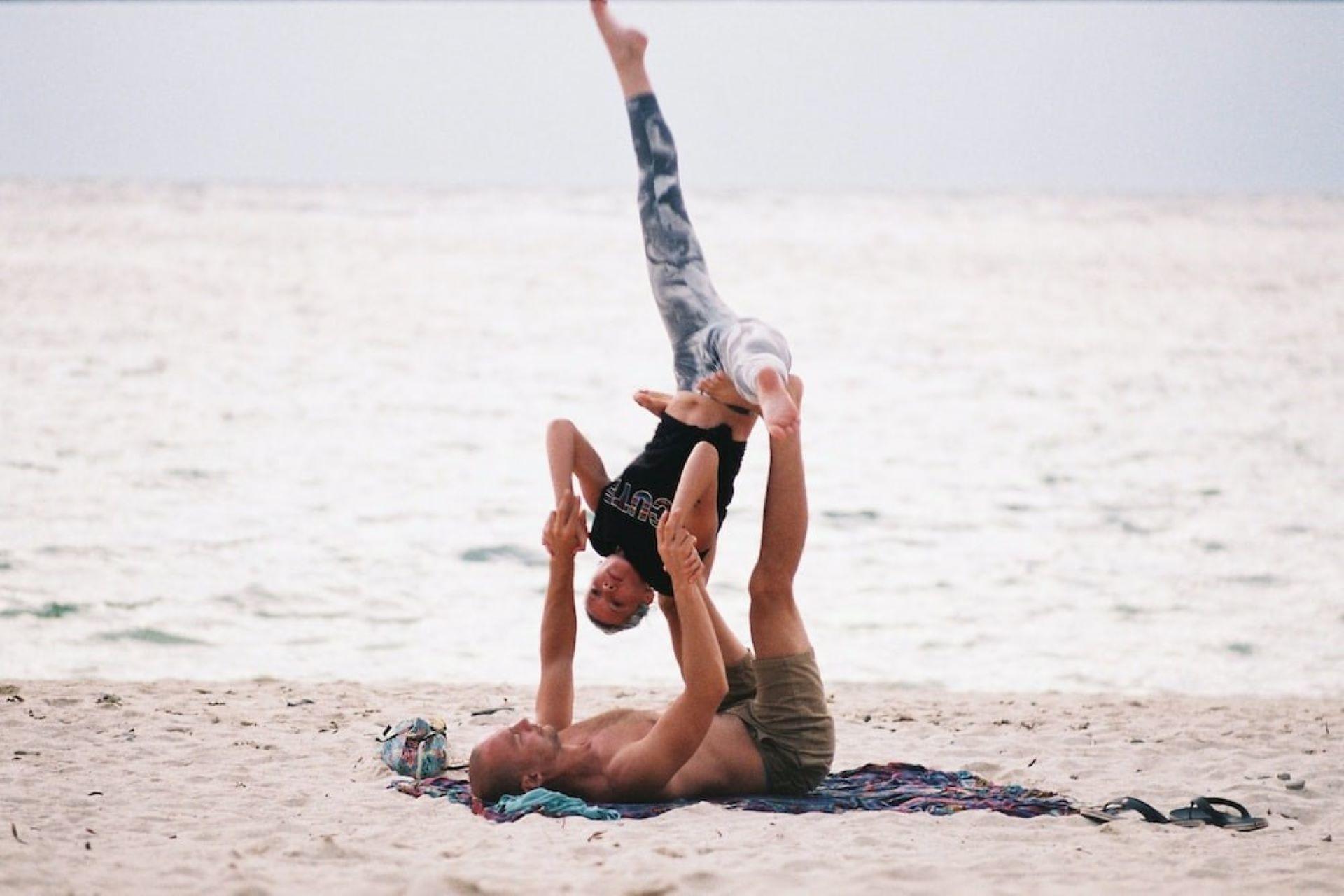As the name suggests, AcroYoga is an exercise routine involving aspects of acrobatics and traditional yoga. It tests the performer's core strength, flexibility, and stability.
AcroYoga usually involves making spectacular figures above the ground. It can help build a stronger bond between the two practitioners, requiring mutual trust, physical touch, cooperation, and a deep understanding of each other's body signs. The traditional AcroYoga requires two or more partners but can be done alone.
The exact origins of AcroYoga are unknown; however, manuals and tutorials from as far back as 1938 show that a similar exercise has been practiced. In 1985, Benjamin Marantz, a yoga instructor and therapist developed a form of flying postures and massage techniques called Acrosage.
Later in the 1980s, Ken Nateshvar Scott introduced yoga, a more solo practice, to a broader audience. Eugene Poku and Jessie Goldberg founded the AcroYoga Montreal (AYM) in 1999, which became fully functional in 2003. Their version of AcroYoga was interesting; it involved elements of dance, yoga, and acrobatics. Jenny Sauer-Klein and Jason Nemer founded AcroYoga International (AYI) in 2003 to give it worldwide exposure, creating an approach to training teachers.
This article will discuss different aspects of AcroYoga, including tips for people just starting and how online tutors such as Superprof can help you learn AcroYoga efficiently.


The Three Fundamental Roles In AcroYoga
AcroYoga requires a lot of focus and balance. In order to properly execute the poses, there are three fundamental roles.
BASE
The person that plays the base is closest to the ground. In AcroYoga, they are often the ones lying flat on the ground, their arms and legs stretched out and extended into the air. This position is usually completed by another person balancing on the base.
This, however, does not mean the base always lays on the ground. They can also be standing in Standing Acro or lying on their belly in Belly Basing). The base's purpose is to act as support for the flyer above them. A base with experience is tough, stable, and flexible. This way, they can provide a firm foundation for the flyer to balance on.
FLYER
The flyer is called so because they are "flying" on top of the base. The flyer balances itself atop the base by being in contact with the base at a few points. This keeps them held above the ground. This can be done in various ways. The flyer should be able to fit their body's tension perfectly. They must also know how to move while maintaining their balance in the air.
A flyer is strong and well aware of their body's position and balance. They should also be able to control this position, balance themselves, and move about with fluidity.
SPOTTER
The spotter acts as extra support. They play a crucial role in executing AcroYoga poses when the flyer and the base are beginners. Their primary responsibility is to ensure the AcroYoga exercises go safely. The spotter's primary purpose is to ensure the flyer remains safe. They are constantly present around the flyer and stay alert to catch them in case of a potential fall or support the flyer and base to prevent them from losing balance by hands-on spotting until the base and flyer are confident enough to participate in the exercise with less support.

The Benefits Of AcroYoga
AcroYoga is a fun way to remain healthy and improve mindfulness when done correctly and with the right person. AcroYoga is purposed to lighten the mood by releasing adrenaline and endorphins in your body.
Many people fret about whether is AcroYoga hard and how to learn AcroYoga. This incredible blend of acrobatics and traditional hatha yoga brings people closer together, helps you interact with people easily, increases confidence, and removes barriers and prejudices on physical touch.
The exercise encourages a deep connection of trust between the two practitioners, betters communication, and even non-verbal communication. AcroYoga may even enhance your ability to understand your partner, understand them through gestures or moments that may not mean anything to a third person.
Regular practice of AcroYoga is beneficial to your physical balance. One significant purpose of AcroYoga is to enhance your attention span and ability to focus. A healthy physical balance also results in a healthy mental balance.
The exercise is so broad that anytime you master one form, you always have another one waiting to be learned. It challenges you to look for and discover new forms. Trust is the building foundation of AcroYoga. Regular practice helps you gain trust in other people, encouraging better human relationships. Given the plethora of benefits that Acroyoga has to offer, it is natural for you to be tempted to search the web for AcroYoga workshops near me. But don't worry, as Superprof has got you covered with its exceptional acrobatic classes near me.

Physical Benefits of AcroYoga
The primary benefits of AcroYoga are;
- Improved flexibility
- A stronger core and muscles
- Fatigue resistance.
Your cardiovascular system also benefits from this due to the exercise's more intense nature compared to other forms of yoga. Alongside this, it also strengthens your joints, making them more robust and flexible. To increase these benefits, perform this exercise in the open sky to benefit from fresh air.
AcroYoga can have therapeutic effects, joining massage techniques, inversions and regression when performed in a specific way.
A branch of AcroYoga known as therapeutic flying offers deep body and mind relaxation, stretching the spine and loosening tension. The base benefits from this by developing a sense of responsibility and care towards other people.
How To Start Learning AcroYoga
Often, people with some background in either yoga or acrobatics can start practicing themselves by testing different forms. However, to learn AcroYoga's purpose and techniques, it is advised to study AcroYoga from a teacher with experience. They will effectively guide you through the steps needed to learn this practice safely and proficiently.
After mastering the basics, consider becoming a part of AcroYoga events called jams. Here, expert practitioners and enthusiastic learners train collectively with a group of AcroYoga enthusiasts.
As far as techniques are concerned, it would be best if you referred to an expert practitioner. An important feature of AcroYoga poses that you must learn is bone stacking. This helps the base spread the flyer's weight evenly onto the ground. These techniques can be taught by one of our AcroYoga experts at Superprof.

Tips For Beginners
If you are just starting out and searching for beginner AcroYoga classes near me, it is important to prepare yourself. Here are a few things you should be mindful about;
- Look for AcroYoga classes, either online or physically. Look for classes that teach multiple people at once. Even an individual teacher or partner is a great way to start
- Put effort into developing a strong relationship of trust between you and your partner, and get to know each other's weaknesses and strengths so you two can work efficiently
- In case you are in a group, it is advisable for you to begin the session with a sharing circle to increase trust and promote openness
- Never start your practice immediately. Always begin with a warm-up. Do gentle muscle and joint stretching exercises to loosen up your body
- Eventually, shift to more rigorous warm-ups to fit your increasing AcroYoga abilities
- Begin practicing with your partner. Start with a standing form. In this form, the flyer leans on the base. They place their feet on the groin or take assistance from a handgrip. The base carries the entire weight when the flyer stops depending on the balancing point, completely trusting their base. Ideally, the base should be able to support the flyer. They hold this position for a while. Then, the base slowly pushes the flyer away and back into their standing position. This is repeated several times to perfect their balance
- Always start from the fundamental poses, and move up to the more complex ones only when you both feel confident
- Keep a close eye on your balance, keep hold of your most stable contact point, and work on them. You are required only to hold it for a few seconds, but it increases eventually. Pace yourself, and make sure to take breaks
- Try to switch roles. This will help you get a perspective of each position and do better
- Always have a spotter present until you have mastered all basic AcroYoga poses
Want To Learn AcroYoga With Our Experts At Superprof?
Learning AcroYoga can be an incredible experience for the mind and the body. Many people believe that it is a great way to start your day. However, there are certain things that beginners need to take care of before they start.
While you could probably find a slew of videos online that can teach you the basics and prepare you for AcroYoga, these videos are not enough to train you effectively. What you need is a personal trainer that can design a session based on your skill level and needs. This is where Superprof comes in.
We have a team of seasoned experts in the art of AcroYoga that you can hire to be your tutor. Visit Superprof today and see how our experts can help you learn AcroYoga.
Résumer avec l'IA :
















